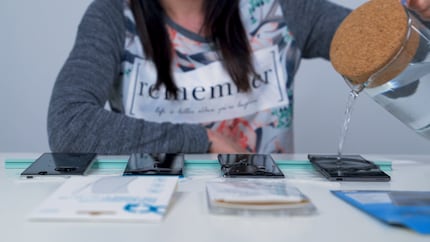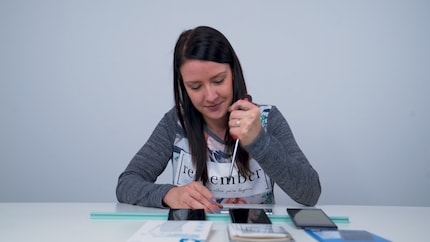
Nano, TitanShield or film: phone screen protection tested
Melanie called Anna Lee to test her replacement phones. The question: What's the best way to protect your display - with a TitanShield, a nano coating or a protective film? She looks into it.
"Hey, we can finally test protective films and stuff," Customer Care Representative Melanie Anna Lee tells me in conversation. The reason: the fleet of replacement phones is being replaced in the Zurich shop. If you have to send in your main smartphone for repair, you can't just stand there without a mobile phone. That's why the shops each have a small fleet of phones. They are mucked out every few years. The devices with faults, broken batteries or other damage are recycled and replaced. Melanie has a box of nine old Wiko devices in front of her and says that we can finally test the films.
"Finally?
"Finally?" I ask. Because I don't know anything about such a test.
She explains the situation: she is shown so many cracked screens in the shop. That's why she knows that a protective film can save a lot of trouble. "That's why I recommend a film and/or a case to everyone."
"I'll see if we can manage that," I say. Melanie takes that as a "yes" and puts nine old Wikos on the table for me. OK, then we'll just have to. Video producer Manuel Wenk is happy to be involved. As a recreational extreme sportsman, he is also worried about his display. So the old Wiko Highway Stars are given a really hard time before the recycling bin.
Our test setup looks like this: We have four old Wiko Highway Stars, a jug of water and a toolbox. Plus the following films.
Two foils are stuck on. The nano-coating is apparently made from a damp cloth. "You can compare it to a glasses cleaning cloth, simply that it smears your phone and leaves an invisible film on it," says Melanie. As a precaution, she goes round again and makes sure that every spot on the display is rubbed in. This is followed by ten minutes of drying time. The manufacturer recommends 20 minutes, but we in the studio don't care.
We leave a Wiko untreated for comparison. It is tested as it comes out of the box. We don't give this device a high chance of survival.
It gets wet
A jug of water, a slight rise and Melanie in front of the camera. After we've made sure that the studio spotlights' power strips aren't in the dripping area of the water, she gets to work.
"Should I just pour water over it now?" she asks.
"Yes, I don't see why not," I say. Manuel looks more or less simultaneously at the display of his mobile, which he is using to capture a live feed from the overhead camera, and the display of the secondary camera.
But to be honest, there's a lot to be said against it. We've all been there. As soon as your smartphone comes anywhere near a drop of water, you start to worry. It's probably going to implode, burst into flames and you won't be able to write any more WhatsApp messages. You've had this worry for years and even though smartphones are now waterproof and dustproof, you've been worried about "electronics plus water" since you were a child. It's difficult to overcome this instinct.
Melanie pours away.
The result: the water runs off all four highway stars. Water only collects on a slightly protruding edge of the DiamondProtected Phone. The untreated phone performs surprisingly well.

The watering test
How do the phones fare against scratch attacks?
You've been there: you get 2.65 francs of return money at the till. Instead of neatly putting it in the coin pocket of your wallet, you briefly slip it into your trouser pocket. Where your phone is. Ratchet. Scratches in the display.
That's why Melanie grabs a five-figure coin and gets to work on the mobile phones.
First she tries to scratch it properly. Nothing happens. The display on all four phones is unimpressed. However, it has to be said that the fleet of replacement phones is usually selected to be particularly resistant. Of course, the untreated Phone #4 is also unimpressed by the clout.
It gets harder. Melanie presses the five-litre on the display and starts rubbing back and forth. Three of the four phones are unimpressed. Only the Xqisit film is affected. Melanie lets out an "Oha". After the initial shock has passed, Melanie examines the damage.
"Easy, it's just the film," she says. The display under the film is intact. If this were to happen to you in everyday life, you could just peel off the film, buy a new one and then go dancing again with a handful of coins in your pocket.
Melanie stings
At the end, the customer advisor wants to test the impact resistance of the foils. She knows from experience that the untreated phone can withstand a lot. But the films on it

"Just because the Wikos are almost bombproof doesn't mean that all phones are as stable," says Melanie. She asks if we want to see something cool, grins broadly, picks up phone #4 and smashes it full force, display first, into the corner of the table. Manuel and I are a little taken aback.
"Oh, they don't mind," she says, "Look!" In fact, there's nothing to see. The display is still working, no scratches, no cracks, nothing at all.
So tougher guns.
"Cross or flat?" I ask.
"Cross," replies the German with the tattooed arm and I give her a screwdriver from the toolbox that I took from the Do-it-Product Management office earlier.
She thinks about it.
She considers whether she should try scratching again. But then she goes all killer, holds the screwdriver like a knife and stabs the phones. Once, twice, several times. Every screwdriver stab reverberates in the studio.
Phone #1 with the DiamondProtect Nano Coating surprises. So far, the phone hasn't really stood out from the competition. So far, we haven't noticed any significant difference between Nano Coating and nothing at all. Neither in terms of appearance nor effect. But now we do.
After about three hard stabs with the screwdriver, the display of the untreated phone breaks. Melanie now stabs the nanophone. Nothing. The coating and the display hold. The manufacturer of the Nano Coating, DiamondProtect, promises on the packaging that rubbing a cloth on a clean display will make the display up to 600 per cent harder, drop-proof and everything. Before this test, we thought that sounded a lot like nonsense. But not anymore.
The summary
The mess is cleaned up, Melanie sits on the stool in the studio. The conclusion? It's difficult, she says, looking at the battered Wikos, which she has passed on to customers hundreds of times and which are now going to the eternal hunting grounds. The film, which has already given up when scratched, is actually quite good because it is cheap and easy to replace.
The TitanShield is simply a bulwark of a protective mechanism that can withstand pretty much anything, but makes the phone a little chunkier. However, users get used to it extremely quickly, says Melanie, who also has a TitanShield on her private mobile phone.
"Well, what can I say," she sighs, "Okay, maybe this: screen protection definitely helps." She glances at the toolbox.
"Can I have a quick hammer?"
Journalist. Author. Hacker. A storyteller searching for boundaries, secrets and taboos – putting the world to paper. Not because I can but because I can’t not.

